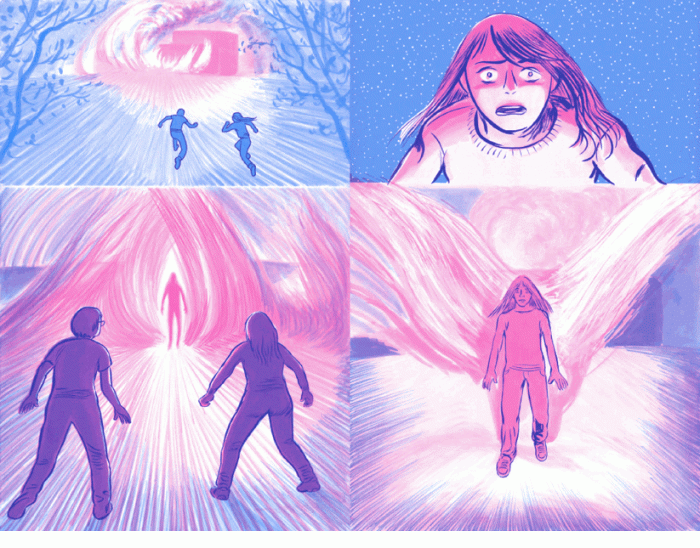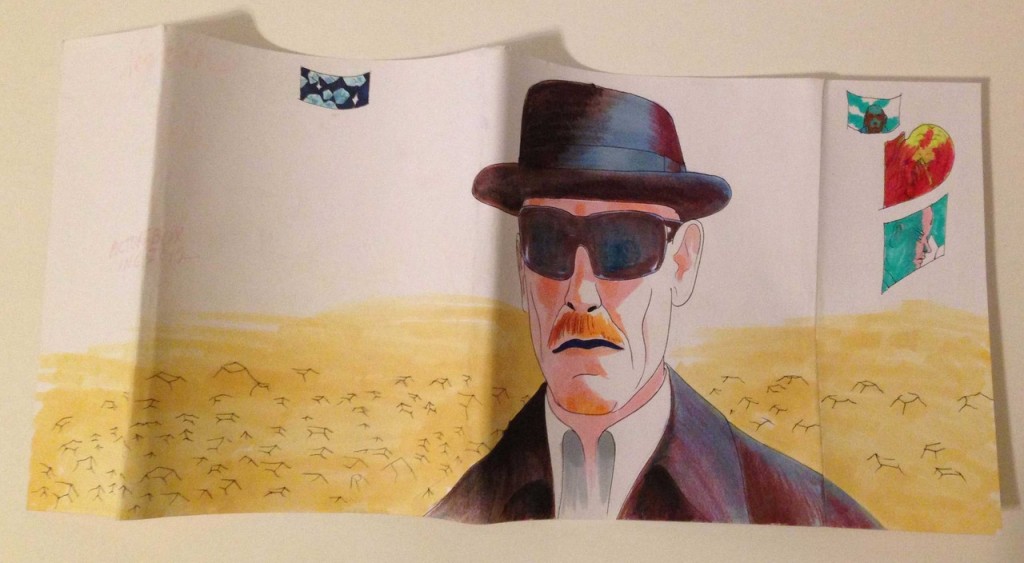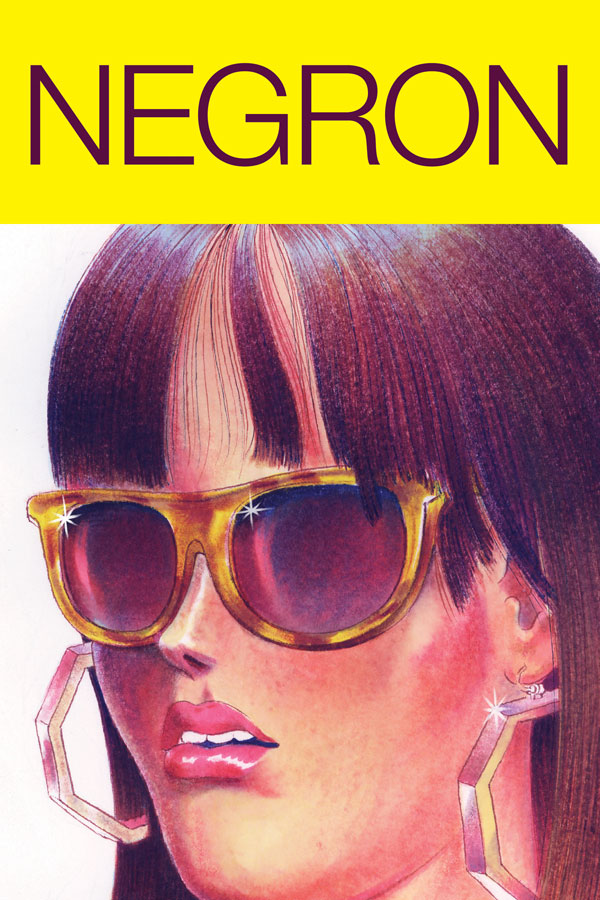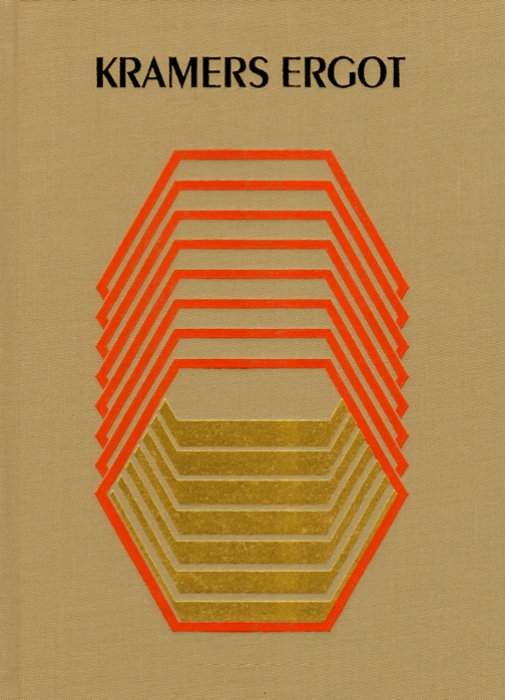Posts Tagged ‘PictureBox’
Fantagraphics and PictureBox
December 4, 2013Fantagraphics is the greatest comics publisher of all time. No company, in any field, has made products that mean more to me than Fantagraphics’. Their co-publisher Kim Thompson died too young and took a lot of counted-on revenue with him, so they launched a Kickstarter that’s in its final hours right now. The rewards are almost parodically plentiful, varied, and worthwhile; I’ll be getting a customized pair of Chuck Taylors, naturally. I urge you to give if you haven’t already — it’s basically shopping, not giving, but either way, the company that basically created alternative comics could use your help.
PictureBox is the greatest comics publisher of the 21st century. Any one of several projects published or edited by publisher Dan Nadel would make him and PBox a publisher for the ages: the work of Japanese experimentalist Yuichi Yokoyama or prescient Providence art-comics collective Paper Rad, editing the canon-disrupting classic-comics collection Art Out of Time or the paradigm-shifting magazine of alt/genre comics criticism Comics Comics. PBox also did a huge service for alt/art comics by situating them in the larger context of visual culture — in publishing collections by everyone from Richard Kern to Hipgnosis to the Hairy Who to Destroy All Monsters in addition to the best-ever books by, say, Brian Chippendale and Renee French, Nadel was making a case for commonalities that might otherwise have gone un-remarked upon. Now Dan’s closing up shop to take a more stable full-time job in the book world, so PictureBox is having an inventory-liquidating 50% off sale on everything it sells. I put together a quick list of some of the publisher’s more narratively straightforward works for a friend who was looking for recommendations along those lines.
POWR MASTRS: I suspect this seminal CF series is destined to be forever unfinished, at least in terms of its original conception as an eight-volume epic or something, but it’s basically an NC-17 Adventure Time.
COLD HEAT: Another Unfinished Symphony, though much less dramatically so; in fact you’re better off skipping the final double issue, which makes this weird huge tonal shift away from the rest of it, the rest of it being “What if someone transformed Loveless by My Bloody Valentine into a young-adult fantasy?” Co-creators Frank Santoro and Ben Jones were tentpole PictureBox franchises.
KRAMERS ERGOT 8: In some ways this is the least innovative of the super-duper-influential Kramers anthologies edited by Sammy Harkham, even the least successful, but it’s the most straightforward in terms of the emphasis on nice lengthy narratives from the contributors, and the most thought-provoking in terms of trying to suss out what was included and why, and the coolest-looking in terms of that far-out ’70s science-textbook look.
NEGRON: A great little showcase of the comics and pin-ups of the postmillennial Vaughn Bode.
EVERYTHING TOGETHER: This is a collection of all the short stories by Sammy Harkham, an alternative cartoonist in the grand Fanta/D&Q tradition.
GARDEN: There’s no story here, per se — it’s just a bunch of people in strange costumes navigating an enormous manmade amusement-park-like garden complex and discussing what they see. But Yuichi Yokoyama’s art is just super super appealing to me — he makes every movement seem as dynamic as a Jack Kirby spread, and the overall effect is like going on a strange guided tour of a depopulated Super Mario Galaxy.
It’s worth contemplating how the death of Kim Thompson forced Fantagraphics to crowdfund its continued existence, and how a life change on Dan Nadel’s part shuttered PictureBox entirely. The alt/art comics infrastructure depends on the heroic efforts of individuals; lose them and the loss can rarely be weathered, with the recent shift of the Brooklyn convention currently called CAB to an exclusively Gabe Fowler-run enterprise from one he shared with Nadel and Bill Kartalopoulos being a rare counterexample.
That said, altcomix is very good at rising from the ashes. Tom Devlin’s Highwater Books, the most direct aesthetic antecedent for PictureBox in terms of their books’ high-end design flourishes and signal-boosting of the Fort Thunder/Providence scene, spawned any number of publishers after it folded: Secret Acres and Bodega Books were both founded by former Highwater employees, Devlin himself went on to partially Highwaterify Drawn & Quarterly, and so on. Dan keeping the doors open at PBox long enough to place as many of his artists and projects with other publishers as possible tells you an awful lot about the quality of his character as well. So, we shop, and we hope.
RIP BCGF
May 16, 2013Partners Gabe Fowler, Bill Kartalopoulos, and Dan Nadel have announced that they are discontinuing the annual Brooklyn Comics and Graphics Festival. There won’t be another one.
BCGF was (god, it sucks to put it that way) the very best comics show I’ve ever been to. Hands down. Every year I went there was something interesting at every table. That’s unheard of — a freakishly high level of talent among the exhibitors. That speaks directly to the partners and curators’ pedigree and clarity of vision, which will be very difficult to replicate. It’s a huge loss for alternative comics.
All this on the very landmass I live on, a 40-minute drive away. I am so sad. Thanks Bill, Gabe, Dan. You did it.
Comics Time: Cold Heat
March 29, 2013I wrote about Ben Jones & Frank Santoro’s unfinished neopsychedelic masterpiece Cold Heat for Vorpalizer. To be played at maximum volume.
Negron/Heisenberg
November 16, 2012(via)
Hey, look what came in the mail!
August 14, 2012NEGRON
March 14, 2012This gets its own post:
Negron
by Jonny Negron
Softcover
80 full color, high gloss pages
6″ x 8″
$19.95
PictureBox, September 2012
more here
Comics Time: Kramers Ergot 8
January 18, 2012Kramers Ergot 8
Robert Beatty, Gabrielle Bell, Chris Cilla, Anya Davidson, Ron Embleton, C.F., Sammy Harkham, Tim Hensley, Kevin Huizenga, Ben Jones, Frederic Mullalley, Takeshi Murata, Gary Panter, Johnny Ryan, Leon Sadler, Frank Santoro, Dash Shaw, Ian Svenonius, writers/artists
Sammy Harkham, editor
PictureBox, January 2012
232 pages, hardcover
$32.95
Buy it from PictureBox
Buy it from Amazon.com
For today’s Comics Time review, please visit The Comics Journal.
The 20 Best Comics of 2011
January 1, 201220. Uncanny X-Force (Rick Remender and Jerome Opeña, Marvel): In a year when the ugliness of the superhero comics business became harder than ever to ignore, it’s fitting that the best superhero comic is about the ugliness of being a superhero. Remender uses the inherent excess of the X-men’s most extreme team to tell a tale of how solving problems through violence in fact solves nothing at all. (It has this in common with most of the best superhero comics of the past decade: Morrison/Quitely/etc. New X-Men, Bendis/Maleev Daredevil, Brubaker/Epting/etc. Captain America, Mignola/Arcudi/Fegredo/Davis Hellboy/BPRD, Kirkman/Walker/Ottley Invincible, Lewis/Leon The Winter Men…) Opeña’s Euro-cosmic art and Dean White’s twilit color palette (the great unifier for fill-in artists on the title) could handle Remender’s apocalyptic continuity mining easily, but it was in silent reflection on the weight of all this death that they were truly uncanny.
19. The League of Extraordinary Gentlemen Vol. 3: Century #2: 1969 (Alan Moore and Kevin O’Neill, Top Shelf/Knockabout): I’ll admit I’m somewhat surprised to be listing this here; I’ve always enjoyed this last surviving outpost of Moore’s comics career but never thought I loved it. But in this installment, Moore and O’Neill’s intrepid heroes — who’ve previously overcome Professor Moriarty, Fu Manchu, and the Martian war machine — finally succumb to their own excesses and jealousies in Swinging London, allowing a sneering occult villain to tear them apart with almost casual ease. It’s nasty, ugly, and sad, and it’s sticking with me like Moore’s best work.
18. The comics of Lisa Hanawalt (various publishers): As I put it when I saw her drawing of some kind of tree-dwelling primate wearing a multicolored hat made of three human skulls stacked on top of one another, Lisa Hanawalt has a strange imagination. And it’s a totally unpredictable one, which is what makes her comics – whether they’re reasonably straightforward movie lampoons or the extravagantly bizarre sex comic she contributed to Michael DeForge and Ryan Sands’s Thickness anthology, as dark and damp as the soil in which its earthworm ingénue must live – a highlight of any given day a new one pops up.
17. Daybreak (Brian Ralph, Drawn and Quarterly): Fort Thunder’s single most accessible offspring also proves to be its bleakest, thanks to an extended collected edition that converts a rollicking first-person zombie/post-apocalypse thriller into a troubling meditation on the power of the gaze. Future artcomics takes on this subgenre have a high bar to clear.
16. Habibi (Craig Thompson, Pantheon): It’s undermined by its central characters, who exist mainly as a hanger on which this violent, erotic, conflicted, curious, complex, endlessly inventive coat of many colors is hung. But as a pure riot of creative energy from an artist unafraid to wrestle with his demons even if the demons end up winning in the end, Habibi lives up to its ambitions as a personal epic. You could dive into its shifting sands and come up with something different every time.
15. Ganges #4 (Kevin Huizenga, Coconino/Fantagraphics): Huizenga wrings a second great book out of his everyman character’s insomnia. It’s quite simple how, really: He makes comics about things you’d never thought comics could be about, by doing things you never thought comics could do to show you them. Best of all, there’s still the sense that his best work is ahead of him, waiting like dawn in the distance.
14. The Congress of the Animals (Jim Woodring, Fantagraphics): The potential for change explored by the hapless Manhog in last year’s Weathercraft is actualized by the meandering mischief-maker Frank this time around. While I didn’t quite connect with Frank’s travails as deeply as I did with Manhog’s, the payoff still feels like a weight has been lifted from Woodring’s strange world, while the route he takes to get there is illustrated so beautifully it’s almost superhuman. It’s the happy ending he’s spent most of his career earning.
13. Mister Wonderful (Daniel Clowes, Pantheon): Speaking of happy endings an altcomix luminary has spent most of his career earning! Clowes’s contribution to the late, largely unlamented Funny Pages section of The New York Times Magazine is briefly expanded and thoroughly improved in this collected edition. Clowes reformats the broadsheet pages into landscape strips, eases off the punchlines and cliffhangers, blows individual images up to heretofore unseen scales, and walks us through a self-sabotaging doofus’s shitty night into a brighter tomorrow.
12. The comics of Gabrielle Bell (various publishers): Bell is mastering the autobiography genre; her deadpan character designs and body language make everything she says so easy to buy – not that that would be a challenge with comics as insightful as her journey into nerd culture’s beating heart, San Diego Diary, just by way of a for instance. But she’s also reinventing the autobiography genre, by sliding seamlessly into fictionalized distortions of it; her black-strewn images give a somber, thoughtful weight to any flight of fancy she throws at us. What a performance, all year long.
11. The Armed Garden and Other Stories (David B., Fantagraphics): Religious fundamentalism is a dreary, oppressive constant in its ability to bend sexuality to mania and hammer lives into weapons devoted to killing. But it has worn a thousand faces in a millennia-long carnevale procession of war and weirdness, and David B. paints portraits of three of its masks with bloody brilliance. Focusing on long-forgotten heresies and treating the most outlandish legends about them as fact, B.’s high-contrast linework sets them all alight with their own incandescent madness.
10. Too Dark to See (Julia Gfrörer, Thuban Press): It was a dark year for comics, at least for the comics that moved me the most. And no one harnessed that darkness to relatable, emotional effect better than Julia Gfrörer. Her very contemporary take on the legend of the succubus was frank and explicit in its treatment of sexuality, rigorously well-observed in its cataloguing of the spirit-sapping modern-day indignities that can feed depression and destroy relationships, and delicately, almost tenderly drawn. It’s like she held her finger to the air, sensed all the things that can make life rotten, and cast them onto the pages. She made something quite beautiful out of all that ugly.
9. The comics and pixel art of Uno Moralez (self-published on the web at unomoralez.com): What if an 8-bit NES cut-scene could kill? The digital artwork of Uno Moralez — some of it standard illustrations, some of it animated gifs, some of it full-fledged comics — shares its aesthetic with The Ring‘s videotape or Al Columbia’s Pim & Francie: a horror so cosmically black, images so unbearably wrong, that they appear to have leaked into and corrupted their very medium of transmission. Moralez fuses crosses the streams of supernatural trash from a variety of cultures — the legends and Soviet art of his native Russia, the horror and porn manga of Japan, the B-movies and horror stories of the States, the formless sensation aesthetic of the Internet itself — into a series of images that is impossible to predict in its weirdness but totally unflagging in its sense that you’d be better off if you’d never laid eyes on it. I can’t wait to see more.
8. The comics of Michael DeForge (various publishers): The last time you saw a cartoonist this good and this unique this young, you were probably reading the UT Austin student newspaper comics section and stumbling across a guy named Chris Ware. All four of DeForge’s best-ever comics — his divorced dad story in Lose #3, his shape-shifting/gender-bending erotica in Thickness #2, his self-published art-world fantasia Open Country, and his gorgeously colored body-horror webcomic Ant Comic — came out this year, none of them looking anything at all like anything you could picture before seeing your first Michael DeForge comic. It’s almost frightening to think where he’ll be five years from now, ten years from now…or even just this time next year.
7. The comics and art of Jonny Negron (various publishers): What if someone took Christina Hendricks’s walk across the parking lot and trip to the bathroom in Drive and made an entire comics career out of them? That is an enormously facile and reductive way to describe the disturbing, stylish, sexy, singular work of Jonny Negron, the breakout cartoonist of the year, but it at least points you in the right direction. No one’s ever thought to combine his muscular yet curiously dispassionate bullet-time approach to action and violence, his Yokoyama-esque spatial geometry, his attention to retrofuturistic fashion and style, his obvious love of the female body in all its shapes and sizes, and his ambient Lynchian terror; even if they had, it’d be tough to conceive of anyone building up his remarkable body of work in such a short period of time. Open up your Tumblr dashboard or crack an anthology (Thickness, Mould Map, Study Group, Smoke Signal, Negron and Jesse Balmer’s own Chameleon), and chances are good that Negron was the weirdest, best, most coldly beautiful thing in it. It’s like a raw, pure transmission from a fascinating brain.
6. The Wolf (Tom Neely, I Will Destroy You): Neely’s wordless, painted, at-times pornographic graphic novel feels like the successful final draft to various other prestigious projects’ false starts. It’s a far less didactic, more genuinely erotic attempt at high-art smut than Dave McKean’s Celluloid; a less self-conscious, more direct attempt at frankly depicting both the destructive and creative effects of sex on a relationship via symbolism than Craig Thompson’s Habibi; a blend of sex and horror and narrative and visual poetry and ugly shit and a happy ending that succeeds in each of these things where many comics choose to focus on only one or two.
5. The Cardboard Valise (Ben Katchor, Pantheon): Prep your time capsules, folks: You’d be hard pressed to find an artifact that better conveys our national predicament than Ben Katchor’s latest comic-strip collection, a series of intertwined vignettes created largely before the Great Recession and our political class’s utter failure to adequately address it, but which nonetheless appears to anticipate it. Its message — that blind nationalism is the prestige of the magic trick used by hucksters to financially and culturally ruin societies for their own profit — is delightfully easy to miss amid Katchor’s remarkable depictions of lost fads, trends, jobs, tourist attractions, and other detritus of the dying American Century. He’s the very most funnest Cassandra around.
4. Love from the Shadows (Gilbert Hernandez, Fantagraphics): I picture Gilbert Hernandez approaching his drawing board these days like Lawrence of Arabia approaching a Turkish convoy: “NO PRISONERS! NO PRISONERS!” In a year suffused with comics funneling pitch-black darkness through a combination of sex and horror, none were blacker, sexier, or more horrific than this gender-bending exploitation flick from Beto’s “Fritz-verse.” None also functioned as a rejection of the work that made its creator famous like this one did, either. Not a crowd-pleaser like his brother, but every bit as brilliant, every bit as fearless.
3. Garden (Yuichi Yokoyama, PictureBox): Like a theme park ride in comics form — with the strange events it chronicles themselves resembling a theme park ride — Yokoyama’s book is a breathtaking, breathless experience. Alongside his anonymous but extravagantly costumed non-characters, we simply go along for the ride, exploring Yokoyama’s prodigious, mysterious imagination as he concocts a seemingly endless stream of increasingly strange interfaces between man and machine, nature and artifice. As a metaphor for our increasingly out-of-control modern life it’s tough to top. As pure thrilling kinetic cartooning it’s equally tough to top.
2. Big Questions (Anders Nilsen, Drawn & Quarterly): Last year, I wrote that if the collected edition of Nilsen’s long-running parable of philosophically minded birds and the plane crash that turns their lives upside-down didn’t top my list whenever it came out, it must have been some kind of miracle year. Turns out that it was. But you’d pretty much have to create a flawless capstone to a thirty-year storyline of neer-peerless intelligence and artistry to top this colossal achievement. Nilsen’s painstaking, pointillist cartooning and ruthless examination of just how little regard the workings of the world have for any given life, human or otherwise, marks him as the best comics artist of his generation, and solidifies Big Questions‘ claim as the finest “funny animal” comic since Maus.
1. Love and Rockets: New Stories #4 (Gilbert and Jaime Hernandez, Fantagraphics): Gilbert got his due elsewhere on my list, so let’s ignore his contribution to this issue, which advance the saga of his bosomy, frequently abused protagonist Fritz Martinez both on and off the sleazy silver screen. Instead, let’s add to the chorus praising Jaime’s “The Love Bunglers” as one of the greatest comics of all time, the point toward which one of the greatest comics series of all time has been hurtling for thirty years. In a single two-page spread Jaime nearly crushes both his lovable, walking-disaster main characters Maggie and Ray with the accumulated weight of all their decades of life, before emerging from beneath it like Spider-Man pushing up from out of that Ditko machinery. You can count the number of cartoonists able to wed style to substance, form to function, this seamlessly on one hand with fingers to spare. A masterpiece.
Comics Time: 1-800-MICE
December 2, 20111-800-MICE
Matthew Thurber, writer/artist
PictureBox, 2011
176 pages, hardcover
$22.95
Buy it from PictureBox
Buy it from Amazon.com
For today’s Comics Time review, please visit The Comics Journal.
Comics Time: Garden
May 16, 2011 Garden
Garden
Yuichi Yokoyama, writer/artist
PictureBox, May 2011
320 pages
$24.95
Buy it from PictureBox
Buy it from Amazon.com
Meet the non-narrative pageturner. Garden is Yuichi Yokoyama’s third English-language release from PictureBox, and his most viscerally thrilling work to date. It’s the clearest demonstration yet of the innovation that is his masterstroke: fusing visually and thematically abstract material with the breakneck forward momentum, eye-popping spectacle, and pulse-pounding sense of stakes of the rawest plot-driven action storytelling.
Garden has no story to tell, of course, not as such: It simply depicts a large group of sightseers who break into a vast manmade “garden” of enormous natural features combined with artificial and mechanical objects, wander around, and describe and inquire after what they see. With their matter-of-fact pronouncements (“There are many ponds. This one is jagged. There is a giant ball floating in this one. This one is made of stainless steel. We have now arrived at a significantly larger pond.”) doing the heavy lifting of parsing exactly what we’re looking at for us, we’re freed to simply go along for the ride, marveling at each new environment Yokoyama dreams up. As a feat of sheer bizarre imagination it’s tough to top: I can easily picture standing around with other readers comparing favorites — “I liked the hall of bubbles!” “I liked the stack of boats!” “I liked the river of balls!” “I liked the giant book!” “I liked the polaroid carpet-bombing!” “I liked the monkey bars!” Imagine if everything in Walt Disney World were as alien and strange as the giant golfball Spaceship Earth and you’re almost there. Nearly every new area and attraction practically demands to be stolen and used for a setpiece in someone’s weird alt-SFF webcomic. And with a “narrative” through-line that’s 100% pure exploration — lots of little guys walking and climbing and sliding and crawling through doorways and scaling mountains made of glass and so on — echoes of their tactile, discovery-driven adventure can’t help but hit us and excite us as we race along with them to their eventual destination.
In essence, Garden teaches you how to read it. It immerses you in its perambulations and presents you with a new amazing thing with each turn of the page, engrossing you to the point where you hardly even notice that it’s a book-length exploration on Yokoyama’s part of geometric shapes, of the clean line, of costume design (all the little people wear headgear and outfits that make them look like a cross between Jason Voorhees and Carmen Miranda), of his own fascination with the way the natural world and the manmade world shape one another. I felt at the end of the book like I do at the end of a great theme-park vacation: Exhausted, invigorated, and already planning my return.
Comics Time: Mould Map #1
January 10, 2011Mould Map #1
Jason Traeger, Daniel Brereton, Aidan Koch, Massimiliano Bomba, Stéphane Prigent, Kitty Clark, Matthew Lock, Lando, CF, Jonathan Chandler, Matthew Thurber, Brenna Murphy, Drew Beckmeyer, Colin Henderson, Leon Salder, writers/artists
Hugh Frost, Leon Sadler, editors
Landfill Editions, December 2010
16 large pages
$12
Buy it from Landfill
Buy it from PictureBox
Learn more at MouldMap.com
Ingenious idea, meet ingenious execution. In this gorgeously printed, oversized anthology, a posse of prominent and obscure artcomickers create evocative one-page science-fiction strips/images/whatever — not so much to tell a complete story as to convey a mood, an environment, a series of story possibilities that emerge into the past and future of the events depicted on the page. Aidan Koch’s bold all-caps lettering meshes perfectly with her story of a nude, distraught wanderer of the highways who knows that something terrible is growing inside of him. Lando’s similarly perambulatory protagonist is confronted in the final panel by a reptilian counterpart, the ominous of the sudden meeting conveyed by superimposing a massive image of the creature’s head over the panel itself. CF’s contribution features a warrior in freefall and ends with the phrase “ENTERING ENEMY AIRSPACE” — it stops where the story starts, basically. Jonathan Chandler’s soldiers marvel after one of their fellows — “He really did it. He went out alone after the lights.” — whose journey to a cryptic series of what look like cardboard cutouts of robots or aliens remains unexplained. Many more pages are simply wordless images or wordless series of images featuring vaguely science-fictional figures doing vaguely science-fictional things. The tight space constraints offer the participants a welcome opportunity to step away from the typical worldbuilding concerns of alt/artcomix-genre hybrids and instead focus on world-evoking, a sense of what it would be like to be there, even when you don’t know what or how or why “there” is. The comic is printed in a flourescent orange and blue palette, like Cold Heat‘s pink and blue gone radioactive — a post-apocalypse run by a New York Mets memorabilia cargo cult. It’s a fine package and a delightful combination of form and function.
Comics Time: Powr Mastrs Vol. 3
January 7, 2011Powr Mastrs Vol. 3
CF, writer/artist
PictureBox, October 2010
112 pages
$18
Buy it from PictureBox
Buy it from Amazon.com
When thinking of CF’s revisionist-fantasy series Powr Mastrs, two things usually spring to my mind: Its psychedelic visual flourishes — both the precision and strength with which his wire-thin pencil line imbues them and the way such visuals feel like a natural part of any fantasist’s vocabulary — and its graphic sexuality — equal parts disturbing and erotic, serving perhaps as a substitute for violence, one that’s actually capable of shocking a modern audience. Unfortunately for me that’s often all I think about when I think about the series. But in re-reading all three volumes in preparation for this review, lots more jumped out besides. For one thing, this is a funny comic! From Subra Ptareo’s would-be monasticism to Jim Bored’s futile attempts to get someone, anyone to free him from his prison to the Sub-Men’s shenanigans, it’s frequently LOLtastic. It’s also a lot less rambly and more focused than I remember it: The overarching plot, about Mosfet Warlock’s weird science and various other characters’ attempts to use it for their own ends and/or seek revenge for having been its unwilling guinea pigs, establishes itself right quick and is a constant presence. And back to the sex for a second: It’s hot stuff! And it’s kinky in a way that feels genuine, which takes guts as well as perviness — the naughty part of this volume feels like it emerges from considered contemplation of dominance and submission and how much fun they can be even as they look fairly awful to outsiders. Meanwhile the specifics of CF’s SFF here — the biomechanics, the spellcraft, the bestiary, the economy, the worldbuilding, the whole nine — feel singular and yet still intelligble. What a pleasure to watch an artist make genre come to him and his interests and obsessions rather than the other way around.
Comic of the Year of the Day: If ‘n Oof
December 27, 2010Every day throughout the month of December, Attentiondeficitdisorderly will spotlight one of the best comics of 2010. Today’s comic is If ‘n Oof by Brian Chippendale, published by PictureBox — if you’ve ever wanted to give the Fort Thunder aesthetic a shot, start here.
Hey, have you played the new Brian Chippendale game yet? I’m only exaggerating slightly when I say that reading each successive Chippendale/PictureBox graphic novel is like getting a new installment in your favorite video game series, one that shakes up the gameplay but still feels like an immersion in the original spirit you loved. From Ninja‘s giant-sized hardcover presentation, bright, buoyant black and white art, and slip-sliding layout; to Maggots‘ furtive samizdat scrawled-on-a-used-book origin, dense dark panels, and hiccuppy panel flow; and now to If ‘n Oof‘s doorstop thickness, manga-digest trim size, buddy-action-comedy tone, and one-panel-per-page design, they’re all uniformly and unmistakably Chippendale in story, art, and tone, but vastly different in terms of the sensory effect reading them has. They’re experiential, is what I’m saying–as much about the act of reading as about what is read.
Click here for a full review and purchasing information.
Comics Time: If ‘n Oof
December 13, 2010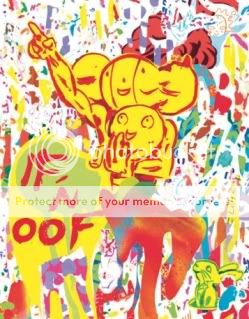 If ‘n Oof
If ‘n Oof
Brian Chippendale, writer/artist
PictureBox, October 2010
800 pages
$29.95
Buy it from PictureBox
Buy it from Amazon.com
Hey, have you played the new Brian Chippendale game yet? I’m only exaggerating slightly when I say that reading each successive Chippendale/PictureBox graphic novel is like getting a new installment in your favorite video game series, one that shakes up the gameplay but still feels like an immersion in the original spirit you loved. From Ninja‘s giant-sized hardcover presentation, bright, buoyant black and white art, and slip-sliding layout; to Maggots‘ furtive samizdat scrawled-on-a-used-book origin, dense dark panels, and hiccuppy panel flow; and now to If ‘n Oof‘s doorstop thickness, manga-digest trim size, buddy-action-comedy tone, and one-panel-per-page design, they’re all uniformly and unmistakably Chippendale in story, art, and tone, but vastly different in terms of the sensory effect reading them has. They’re experiential, is what I’m saying–as much about the act of reading as about what is read.
If ‘n Oof has been billed as the most accessible of the three, and for good reason. There’s no tricky snake-style panel layout to follow: Every page is a splash page! The consequent ability of Chippendale to pretty much know for certain how the reader’s experience will be paced–there’s only so much time it’ll take you to take in each standalone image and either look at the next one or turn the page–enables him to perfectly mimic the beats of an action comedy: an out-of-nowhere save by an offscreen ally; “I’m gettin’ too old for this shit”-style takes when something particularly outlandish presents itself; big spectacular drawn-out leaps through high-rise windows to safety. There was one (hugely important to the story!) reference to Die Hard so explicit I laughed out loud, and hard–not least because it was an enormously emotionally effective reference to boot! Working in this format provides Chippendale with mainstream visual and rhythmic touchstones previously unavailable to him, and it pays off.
Chippendale appears to sense this, and returns the format’s favor by providing his most straightforward story yet. In place of the disjointed purgatorial wanderings of Maggots and the sprawling Deadwood-style story of a criminalized community of Ninja, you’ve got a pretty easy to grok post-apocalyptic sci-fi buddy road movie, with big-eared If and his tiny, mute companion Oof marching through various dangers en route to safety. There are none of the graphically violent or sexual asides or interludes with which Chippendale peppered his earlier works, either; aside from a memorably but not particularly shockingly gross encounter with a tribe of marauding monster-men (It Came from a Mat Brinkman Comic!!!), the violence here is mostly action-blockbuster R-rated level. And even in terms of individual visuals, there are images here that use a smoother line and more traditionally detailed construction than I’ve ever seen from the author before–vast cathedrals that look like something out of Craig Thompson’s Carnet de Voyage, long hallways that evoke the robotic geometry of Yuichi Yokoyama, fields of flowers that wouldn’t look out of place as the endpapers of a Charles Burns comic. They’re impressive moments, but they’re also funny moments for how accessible they are, as if Chippendale was saying “You think I need to do this jagged-edge markmaking shit all the time? Think again, pal.”
But as breezy and adventurous and action-packed and funny and fun as it all was, I started to wonder: “Where’s the bite?” For all his emphasis on comics-as-play, for all his character designs that look like a cross between forgotten He-Man villains and those little pink M.U.S.C.L.E.S toys, for all his obvious love of genre, Chippendale’s comics have a not-so-secret scathing heart–an indictment of contemporary capitalism, the way it disregards and dehumanizes individuals with the bad fortune of getting in the way of what its robber-baron bureaucrats consider progress. Was that going on here? Turns out the answer is yes after all, thanks to the slow-burn reveal, over the course of many chapters, of a familiar-feeling, haunting science-fiction trope. I’m not going to spoil it here, but suffice it to say it calls into question the notion of whether there really ever is breezy, adventurous, action-packed, funny fun to be had. Knowing the optimism Chippendale has displayed in his real life, to say nothing of the ending of Ninja, I suspect his ultimate answer would be “yes there is”–but it ain’t gonna be easy, and that’s even true in his most user-friendly game yet.
Comics Time: Powr Mastrs Vol. 2
November 19, 2008Powr Mastrs Vol. 2
C.F., writer/artist
PictureBox, November 2008
104 pages
$18
My goodness, this is a filthy book! Powr Mastrs Vol. 2 is a “fantasy” in both the generic and sexual senses. A throughline of eroticized mayhem only briefly glimpsed in Vol. 1 (Aphasia the Witch’s boob-bearing corset, and of course the Jellyfish Emperor/Lady Minirex hentai sequence) emerges as the dominant mode of C.F.’s odd indie epic of magic, mad science, and violence. Maybe that’s what makes the violence here so memorable and disturbing–a certain sexualized vulnerability for the victims and animalism for the perpetrators.
The bit everyone’s going to remember from this volume is Ajax Lacewing’s Midnight Express/28 Days Later style dispatch of a giant. The eye-gouging and decapitation are gory enough on their own, but when accompanied by genuinely upsetting smack-talk (“I know you can’t see now, but you can hear me: You’re trash. Giants are trash.”) and Ajax’s erect penis in full money-shot mode, they’re a true violation. The savagery here and throughout (Buell Kazee introduces us to Viskoser Tod, Tetradyne Cola battles Darman Orry) is palpable, as is the sexuality (the Bosch-like construction of Cool George Herc’s nude body, Minirex’s masturbation, the languid psychedelic sensuality of Aphasia and Windlass Wendy Wheetah the Witches, the Sub-Men’s underwater dalliances). And it all makes sense in a way, given that we learn that the plot’s prime mover is the exploitation, and subsequent rebellion, of the sentient creations of the aloof Mosfet Warlock. It’s a strange and sinister mythos, based on the use and abuse of people’s bodies by other people; I can’t help but feel that outside of the world of artcomics there are hardcore SFF readers who would take to this like ducks to water. I’m not entirely convinced that it justifies a $18 price point for what is essentially one-sixth of a larger story, but this is impressive work.
Comics Time: Powr Mastrs Vol. 1
January 4, 2008Powr Mastrs Vol. 1
PictureBox Inc., November 2007
C.F., writer/artist
120 pages
$18
It might be the jellyfish-on-human double-penetration tentacle-sex scene that makes you realize that this is an adult fantasy comic, but that label, “adult,” is really present throughout this first in a projected series of chronicles of the land of New China. For all that characters like Subra Ptareo may be on a quest and Mosfet Warlock may be a mad scientist, their interlocking stories (so far) don’t read like the genre narratives of my youth beyond their fantastic trappings at all. Instead, they’re stories about buying things and selling things, about twentysomethings (or at least twentysomething analogues) meeting new people and flirting with them, about getting stoned, about fucking and deceiving the people you fuck, about being moved to tears by the realization that you’re actually good at what you’ve chosen to do with your life. Where the fantasy really comes in, for me at least, is in the art. C.F.’s simple, childlike line is reminiscent in affect and effect of Frank Santoro’s in their mutual publisher’s Cold Heat, but while the latter relies on open spaces and canny color choices to evoke the both the supernatural and the mental states akin to it, the former gets it done with detail. The result is always shocking, whether a sudden splash page overripe with flowers and foliage or a doggystyle-eye-view close-up of a tentacle-filled vulva. The word I’m really looking for here is psychedelic, not the cheesily amorphous lowest-common-denominator version but the intense wall-of-sound riot of art-information present in a Moscoso font or the crescendo in the Beatles’ “A Day in the Life.” The combination results in as fecund a playground for the imagination as a far more traditional fantasy story, but arrived at from a totally different direction. It’s inspiring.

